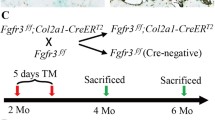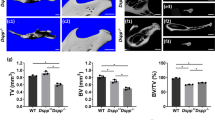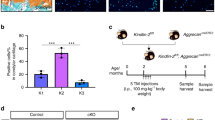Abstract
The temporomandibular joint (TMJ) consists in the glenoid fossa arising from the otic capsule through intramembranous ossification, the fibrocartilaginous disc and the condyle, which is derived from the secondary cartilage by endochondral ossification. We have reported previously that cranial neural-crest-specific inactivation of the homeobox gene Shox2, which is expressed in the mesenchymal cells of the maxilla-mandibular junction and later in the progenitor cells and perichondrium of the developing chondyle, leads to dysplasia and ankylosis of the TMJ and that replacement of the mouse Shox2 with the human SHOX gene rescues the dysplastic and ankylosis phenotypes but results in a prematurely worn out articular disc. In this study, we investigate the molecular and cellular bases for the prematurely worn out articular disc in the TMJ of mice carrying the human SHOX replacement allele in the Shox2 locus (termed Shox2 SHOX-KI/KI). We find that the developmental process and expression of several key genes in the TMJ of Shox2 SHOX-KI/KI mice are similar to that of controls. However, the disc of the Shox2 SHOX-KI/KI TMJ exhibits a reduced level of Collagen I and Aggrecan, accompanied by increased activities of matrix metalloproteinases and a down-regulation of Ihh expression. Dramatically increased cell apoptosis in the disc was also observed. These combinatory cellular and molecular defects appear to contribute to the observed disc phenotype, suggesting that, although human SHOX can exert similar functions to mouse Shox2 in regulating early TMJ development, it apparently has a distinct function in the regulation of those molecules that are involved in tissue homeostasis.




Similar content being viewed by others
References
Ahn HJ, Paik SK, Choi JK, Kim HJ, Ahn DK, Cho YS, Kim YS, Moon C, Bae YC (2007) Age-related changes in the microarchitecture of collagen fibrils in the articular disc of the rat temporomandibular joint. Arch Histol Cytol 70:175–181
Bank RA, Krikken M, Beekman B, Stoop R, Maroudas A, Lafeber FP, Koppele JM te (1997) A simplified measurement of degraded collagen in tissues: application in healthy, fibrillated and osteoarthritic cartilage. Matrix Biol 16:233–243
Berkovitz BK, Robertshaw H (1993) Ultrastructural quantification of collagen in the articular disc of the temporomandibular joint of the rabbit. Arch Oral Biol 38:91–95
Bhaskar SN (1953) Growth pattern of the rat mandible from 13 days insemination age to 30 days after birth. Am J Anat 92:1–53
Blaschke RJ, Hahurij ND, Kuijper S, Just S, Wisse LJ, Deissler K, Maxelon T, Anastassiadis K, Spitzer J, Hardt SE, Schöler H, Feitsma H, Rottbauer W, Blum M, Meijlink F, Rappold G, Gittenberger-de Groot AC (2007) Targeted mutation reveals essential functions of the homeodomain transcription factor Shox2 in sinoatrial and pacemaking development. Circulation 115:1830–1838
Bobick BE, Cobb J (2012) Shox2 regulates progression through chondrogenesis in the mouse proximal limb. J Cell Sci 125:6071–6083
Broussard JS Jr (2005) Derangement, osteoarthritis, and rheumatoid arthritis of the temporomandibular joint: implications, diagnosis, and management. Dent Clin North Am 49:327–342
Burrage PS, Mix KS, Brinckerhoff CE (2006) Matrix metalloproteinases: role in arthritis. Front Biosci 11:529–543
Caltabiano R, Leonardi R, Musumeci G, Bartoloni G, Rusu MC, Almeida LE, Loreto C (2013) Apoptosis in temporomandibular joint disc with internal derangement involves mitochondrial-dependent pathways. An in vivo study. Acta Odontol Scand 71:577–583
Clement-Jones M, Schiller S, Rao E, Blaschke RJ, Zuniga A, Zeller R, Robson SC, Binder G, Glass I, Strachan T, Lindsay S, Rappold GA (2000) The short stature homeobox gene SHOX is involved in skeletal abnormalities in Turner syndrome. Hum Mol Genet 9:695–702
Cobb J, Dierich A, Huss-Garcia Y, Duboule D (2006) A mouse model for human short-stature syndromes identifies Shox2 as an upstream regulator of Runx2 during long-bone development. Proc Natl Acad Sci U S A 103:4511–4515
Ferraz AM Jr, Devito KL, Guimarães JP (2012) Temporomandibular disorder in patients with juvenile idiopathic arthritis: clinical evaluation and correlation with the findings of cone beam computed tomography. Oral Surg Oral Med Oral Pathol Oral Radiol 114:e51–e57
Frommer J (1964) Prenatal development of the mandibular joint in mice. Anat Rec 150:449–461
Garnero P, Rousseau JC, Delmas PD (2000) Molecular basis and clinical use of biochemical markers of bone, cartilage, and synovium in joint diseases. Arthritis Rheum 43:953–968
Gepstein A, Arbel G, Blumenfeld I, Peled M, Livne E (2003) Association of metalloproteinases, tissue inhibitors of matrix metalloproteinases, and proteoglycans with development, aging, and osteoarthritis processes in mouse temporomandibular joint. Histochem Cell Biol 120:23–32
Gu S, Chen YP (2013) Temporomandibular joint development. In: Huang GT-J, Thesleff I (eds) Stem cells in craniofacial development and regeneration. Wiley-Blackwell, New York, pp 71-85
Gu Z, Feng J, Shibata T, Hu J, Zhang Z (2003) Type II collagen and aggrecan mRNA expression by in situ hybridization in rabbit temporomandibular joint posterior attachment following disc displacement. Arch Oral Biol 48:55–62
Gu S, Wei N, Yu X, Jiang Y, Fei J, Chen Y (2008a) Mice with an anterior cleft of the palate survive neonatal lethality. Dev Dyn 237:1509–1516
Gu S, Wei N, Yu L, Fei J, Chen Y (2008b) Shox2-deficiency leads to dysplasia and ankylosis of the temporomandibular joint in mice. Mech Dev 125:729–742
Guarda-Nardini L, Cadorin C, Frizziero A, Ferronato G, Manfredini D (2012) Comparison of 2 hyaluronic acid drugs for the treatment of temporomandibular joint osteoarthritis. J Oral Maxillofac Surg 70:2522–2530
Hering WH (2003) TMJ anatomy and animal models. J Musculoskel Neuronal Interact 3:391–396
Hirschfeldova K, Solc R, Baxova A, Zapletalova J, Kebrdlova V, Gaillyova R, Prasilova S, Soukalova J, Mihalova R, Lnenicka P, Florianova M, Stekrova J (2012) SHOX gene defects and selected dysmorphic signs in patients of idiopathic short stature and Léri-Weill dyschondrosteosis. Gene 491:123–127
Hollander AP, Pidoux I, Reiner A, Rorabeck C, Bourne R, Poole AR (1995) Damage to type II collagen in aging and osteoarthritis starts at the articular surface, originates around chondrocytes, and extends into the cartilage with progressive degeneration. J Clin Invest 96:2859–2869
Kanyama M, Kuboki T, Kojima S, Fujisawa T, Hattori T, Takigawa M, Yamashita A (2000) Matrix metalloproteinases and tissue inhibitors of metalloproteinases in synovial fluids of patients with temporomandibular joint osteoarthritis. J Orofac Pain 14:20–30
Komorowska A (1997) Congenital temporomandibular joint ankylosis—a case report. Eur J Orthod 19:243–248
Kondoh T, Hamada Y, Iino M, Takahashi T, Kikuchi T, Fujikawa K, Seto K (2003) Regional differences of type II collagen synthesis in the human temporomandibular joint disc: immunolocalization study of carboxy-terminal type II procollagen peptide (chondrocalcin). Arch Oral Biol 48:621–625
Krisjane Z, Urtane I, Krumina G, Neimane L, Ragovska I (2012) The prevalence of TMJ osteoarthritis in asymptomatic patients with dentofacial deformities: a cone-beam CT study. Int J Oral Maxillofac Surg 41:690–695
Kubota E, Kubota T, Matsumoto J, Shibata T, Murakami KI (1998) Synovial fluid cytokines and proteinases as markers of temporomandibular joint disease. J Oral Maxillofac Surg 56:192–198
Kubota T, Kubota E, Matsumoto A, Kawai Y, Saito H, Mikuni-Takagaki Y, Sato S (1998) Identification of matrix metalloproteinases (MMPs) in synovial fluid from patients with temporomandibular disorder. Eur J Oral Sci 106:992–998
Landesberg R, Takeuchi E, Puzas JE (1996) Cellular, biochemical and molecular characterization of the bovine temporomandibular joint disc. Arch Oral Biol 41:761–767
Leonardi R, Loreto C, Barbato E, Caltabiano R, Lombardo C, Musumeci G, Lo Muzio L (2008) MMP-13 (collagenase 3) localization in human temporomandibular joint discs with internal derangement. Acta Histochem 110:314–318
Leonardi R, Migliore MR, Almeida LE, Trevilatto PC, Loreto C (2010) Limited fatty infiltration due to apoptosis in human degenerated temporomandibular joint disks: an immunohistochemical study. J Craniofac Surg 21:1508–1511
Liu H, Chen C, Espinoza-Lewis RA, Jiao Z, Sheu I, Hu X, Lin M, Zhang Y, Chen Y (2011) Functional redundancy between human SHOX and mouse Shox2 genes in the regulation of sinoatrial node formation and pacemaking function. J Biol Chem 286:17029–17038
Liu H, Espinoza-Lewis RA, Chen C, Hu X, Zhang Y, Chen YP (2012) The role of Shox2 in SAN development and function. Pediatr Cardiol 33:882–889
Loreto C, Almeida LE, Trevilatto P, Leonardi R (2011) Apoptosis in displaced temporomandibular joint disc with and without reduction: an immunohistochemical study. J Oral Pathol Med 40:103–110
Malemud CJ (2006) Matrix metalloproteinases: role in skeletal development and growth plate disorders. Front Biosci 11:1702–1715
Mazzoni A, Nascimento FD, Carrilho M, Tersariol I, Papa V, Tjäderhane L, Di Lenarda R, Tay FR, Pashley DH, Breschi L (2012) MMP activity in the hybrid layer detected with in situ zymography. J Dent Res 91:467–472
Michikami I, Fukushi T, Honma S, Yoshioka S, Itoh S, Muragaki Y, Kurisu K, Ooshima T, Wakisaka S, Abe M (2012) Trps1 is necessary for normal temporomandibular joint development. Cell Tissue Res 348:131–140
Mills DK, Fiandaca DJ, Scapino RP (1994) Morphologic, microscopic, and immunohistochemical investigations into the function of the primate TMJ disc. J Orofac Pain 8:136–154
Mortazavi SH, Motamedi MH (2007) Congenital fusion of the jaws. Indian J Pediatr 74:416–418
Natiella JR, Burch L, Fries KM, Upton LG, Edsberg LE (2009) Analysis of the collagen I and fibronectin of temporomandibular joint synovial fluid and discs. J Oral Maxillofac Surg 67:105–113
Ochiai T, Shibukawa Y, Nagayama M, Mundy C, Yasuda T, Okabe T, Shimono K, Kanyama M, Hasegawa H, Maeda Y, Lanske B, Pacifici M, Koyama E (2010) Indian hedgehog roles in post-natal TMJ development and organization. J Dent Res 89:349–354
Pessoa JI, Guimarães GN, Viola NV, Silva WJ da, Souza AP de, Tjäderhane L, Line SR, Marques MR (2013) In situ study of the gelatinase activity in demineralized dentin from rat molar teeth. Acta Histochem 115:245–251
Presnell JK, Schreibman MP (1997) Humason’s animal tissue techniques, 5th edn. The Johns Hopkins University Press, Baltimore
Purcell P, Joo BW, Hu JK, Tran PV, Calicchio ML, O'Connell DJ, Maas RL, Tabin CJ (2009) Temporomandibular joint formation requires two distinct hedgehog-dependent steps. Proc Natl Acad Sci U S A 106:18297–18302
Sakakura Y, Hosokawa Y, Tsuruga E, Irie K, Yajima T (2007) In situ localization of gelatinolytic activity during development and resorption of Meckel's cartilage in mice. Eur J Oral Sci 115:212–223
Shibukawa Y, Young B, Wu C, Yamada S, Long F, Pacifici M, Koyama E (2007) Temporomandibular joint formation and condyle growth require Indian hedgehog signaling. Dev Dyn 236:426–434
Sperber HG, Sperber SM, Guttmann GD (2010) Craniofacial embryogenetics and development. PMPH-USA, Shelton
St Amand TR, Zhang YD, Seminar E, Zhao X, HU Y, Nguyen L, Murray JC, Chen YP (2000) Antagonistic signals between BMP4 and FGF8 define the expression of Pitx1 and Pitx2 in mouse tooth forming anlage. Dev Biol 217:323–332
Takahashi H, Sato I (2001) Ultrastructure of collagen fibers and distribution of extracellular matrix in the temporomandibular disk of the human fetus and adult. Okajimas Folia Anat Jpn 78:211–221
Tanaka A, Kumagai S, Kawashiri S, Takatsuka S, Nakagawa K, Yamamoto E, Matsumoto N (2001) Expression of matrix metalloproteinase-2 and −9 in synovial fluid of the temporomandibular joint accompanied by anterior disc displacement. J Oral Pathol Med 30:59–64
Tanaka E, Detamore MS, Mercuri LG (2008) Degenerative disorders of the temporomandibular joint: etiology, diagnosis, and treatment. J Dent Res 87:296–307
Willard VP, Arzi B, Athanasiou KA (2012) The attachments of the temporomandibular joint disc: a biochemical and histological investigation. Arch Oral Biol 57:599–606
Yu L, Gu S, Alappat S, Song Y, Yan M, Zhang X, Zhang G, Jiang Y, Zhang Z, Zhang Y, Chen Y (2005) Shox2-deficient mice exhibit a rare type of incomplete clefting of the secondary palate. Development 132:4397–4406
Yu L, Liu H, Yan M, Yang J, Long F, Muneoka K, Chen Y (2007) Shox2 is required for chondrocyte proliferation and maturation in proximal limb skeleton. Dev Biol 306:549–559
Zhang L, Yang M, Yang D, Cavey G, Davidson P, Gibson G (2010) Molecular interactions of MMP-13 C-terminal domain with chondrocyte proteins. Connect Tissue Res 51:230–239
Author information
Authors and Affiliations
Corresponding author
Additional information
X.L. received a fellowship from the Fujian University of Traditional Chinese Medicine, Fujian, P.R. China. Y.Z. was supported by a fellowship from the Department of Health, Fujian Province, P.R. China. Financial support for this study was provided by an NIH grant (R01 DE17792) to Y.P.C.
The authors declare no potential conflicts of interest with respect to the authorship and/or publication of this article.
Rights and permissions
About this article
Cite this article
Li, X., Liu, H., Gu, S. et al. Replacing Shox2 with human SHOX leads to congenital disc degeneration of the temporomandibular joint in mice. Cell Tissue Res 355, 345–354 (2014). https://doi.org/10.1007/s00441-013-1743-2
Received:
Accepted:
Published:
Issue Date:
DOI: https://doi.org/10.1007/s00441-013-1743-2




